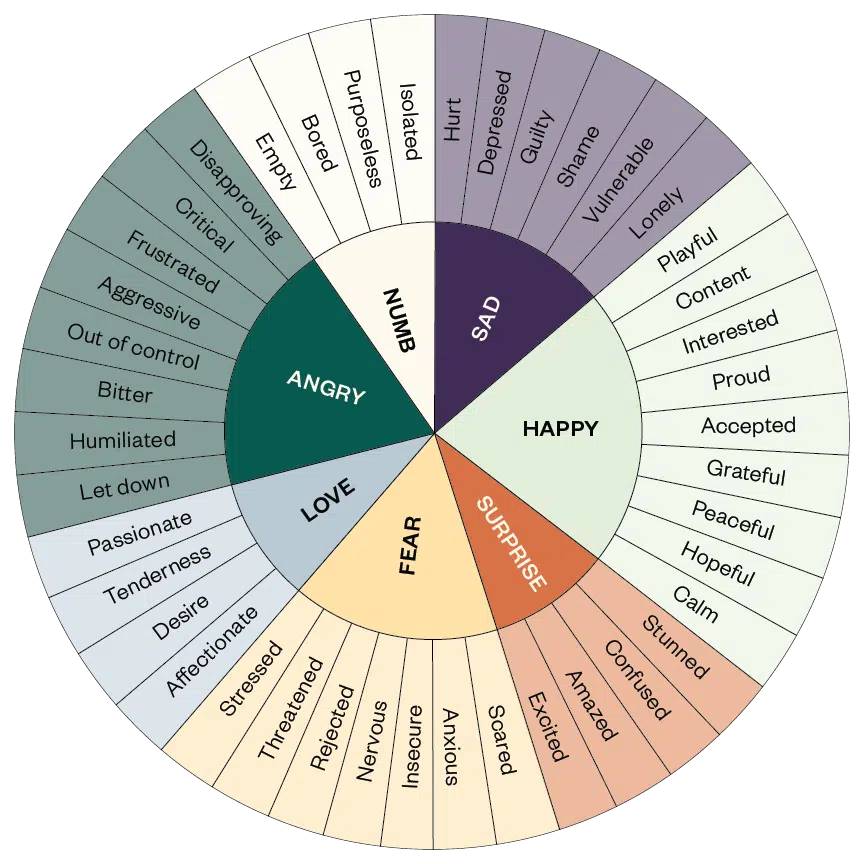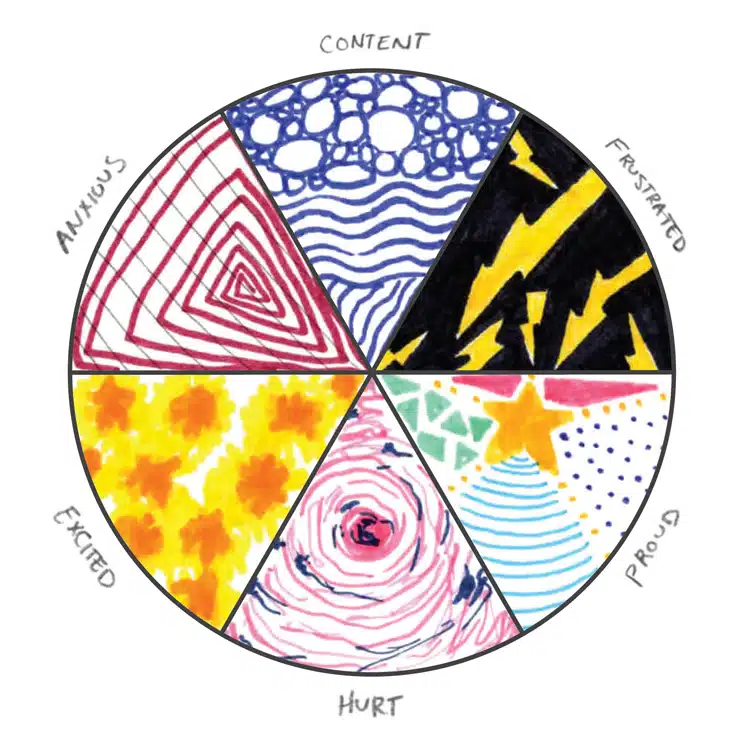Saprea > Online Healing Resources > Our Approach >Healing Resources: Emotion Wheel
Oftentimes, it’s easy to recognize what has a physical impact on our bodies. For example, lifting weights may cause our arms to feel sore the next day, or tripping on the sidewalk may cause a scraped knee. But sometimes our bodies can experience physical changes as a response to something harder to identify: our emotions. For example, you might feel a rush of blood to the head because you’re angry, or your hands might shake because you’re nervous or excited.
It’s also possible to experience multiple emotions at one time, even emotions that seem to be opposites of each other. For example, if you find an important picture on your phone that you thought had been deleted, you may feel both relieved that the picture wasn’t lost and annoyed at the stress you had gone through thinking it was lost in the first place.
For survivors of child sexual abuse, emotions can seem especially complicated, contradictory, and difficult to identify.
Why Is It Important to Identify My Emotions?
Every emotion you experience is important—even the ones you don’t enjoy—because it’s trying to tell you something. As a survivor, your emotions may be informing you of how your brain is responding to the world around you and making connections in the present to the abuse of your past.
Emotions provide a survivor with insight on how something is making them feel, as well as what they need in that moment. For instance, a survivor may note at a family event that their stomach is knotting up. They then connect that physical reaction to the emotion of anxiety. This anxiety, they realize, is a response to being around certain family members who make them uncomfortable. The survivor can then acknowledge that what their brain and body need in that moment is some space away from the party to practice paced breathing and positive affirmations.
Because the survivor was in tune with their emotions and able to identify exactly what they were feeling, they were able to do two things:
- Recognize what caused the emotion.
- Recognize what their brain and body needed in that moment.
Building awareness by labelling the different emotions you are experiencing, both mentally and physically, will help you understand how certain events, settings, or triggers make you feel and why you may be feeling that way. Once you understand what you are feeling and why, you can take the next steps to respond to the emotion you are experiencing—whether that’s practicing a grounding exercise, calling a friend, or walking outside.
Identifying what you are feeling can also help strengthen the connection between the emotions you are experiencing and how those emotions are impacting your body. This connection between the mind and body is especially effective when it comes to feeling stuck in a depressive state or feeling disconnected from your body or your emotions.
What Is an Emotion Wheel and How Can I Use It?
A tool that many survivors of child sexual abuse find helpful is our Emotion Wheel. This wheel helps you identify and better understand the emotion (or emotions) you’re experiencing. Understanding is an integral step in solving any problem or dilemma. Once you understand the emotions that arise for you in certain situations—such as when you feel triggered—you can take steps to ease those emotions.
Giving a name to our emotions is particularly powerful when we have a support group who can offer us help in identifying how we are feeling. Many survivors relate how much relief they experience as they can confide to another person what they are experiencing and receive validation or even just the knowledge that they are not alone in carrying the burden of heavy emotions.

Using the Emotion Wheel to Help with Triggers
To use the Emotion Wheel, first think about an experience in which you felt triggered. Start by looking at the middle of the wheel to identify the core emotion you felt during that experience. Were you angry? Afraid? Sad? Numb? What did you experience physically? Trembling hands? A rush of heat to your face? A heavy weight in your stomach?
From there, move to the outer part of the wheel and look at the feelings associated with that emotion. Don’t necessarily look for an emotion. Rather, take note of which ones resonate with you. Remember that you aren’t trying to “fix” or change your emotions, only become more aware of them.
Repeat this process several times as you think about various experiences that exacerbated a symptom connected to the past abuse. As you do so, take note of patterns. Are there specific emotions you feel when experiencing a specific situation or interacting with a specific person? Do you generally feel the same way in all triggering experiences or do the emotions vary depending on the situation?
Because coping with feelings of aggression often requires different tactics than coping with feelings of insecurity, understanding these patterns is critical to the healing process. Once you have an idea of how your emotions typically respond to triggers, you can make plans to cope with those triggers.
Using the Emotion Wheel to Help Understand Your Needs
Not only are you experiencing emotions in any given moment, but you are also experiencing needs in response to those emotions. We call these responses emotional needs. For instance, if you are experiencing feelings of rejection, then your emotional need may be acceptance and belonging. Or, if you are feeling shame, your emotional need may be self-compassion and curiosity.
Below is a list of common emotional needs that survivors of child sexual abuse experience. Once you identify the emotion(s) you are feeling in the wheel above, you can see if any of these emotional needs listed resonate with you.
If one of the examples does stand out as something you feel you need in this moment, we encourage you to try one of the suggested activities:
Self-Compassion and Curiosity
- Challenge a shameful/unhelpful thought with a mindfulness exercise.
- Imagine a friend in your situation and write a self-compassionate note to them.
Safety and Support
- Practice paced breathing or a grounding exercise.
- Set, or brainstorm, a boundary.
Hope
- Recite positive affirmations
- Write a message from your future self.
Physical Movement
- Try progressive muscle relaxation or stretching.
- Go for a walk outside.
Acceptance and Belonging
- Attend a Saprea Support Group.
- Express your thoughts and feelings to a person you trust.
Using the Emotion Wheel to Understand Your Everyday Emotions
The Emotion Wheel doesn’t only have to be used for understanding triggers. You can use this wheel to identify whatever you may be feeling in any given moment—pleasant or unpleasant, painful or enjoyable.
Because while it’s important to note when your mind and body are responding to emotions of distress, it’s equally important for survivors to observe when they are experiencing emotions of joy, comfort, or peace. Noting such emotions is an important element of Aspiration, as it reminds you that hope and healing are possible, that more moments of contentment or peace are in your future, and that you are continually experiencing change and are not stuck or frozen in your trauma.
So, as you use the Emotion Wheel to check-in with your brain and body, do not feel pressured toward one emotion or another. It’s part of the human experience to carry the weight of heavy emotions that we didn’t ask for (or deserve). Such emotional burdens can be especially prevalent among survivors of child sexual abuse. We want to assure you that healing from trauma doesn’t mean you should get to a place where you always feel upbeat or hopeful. But it can mean that you feel more attune to your emotions, rather than controlled by them. Simply note what you are experiencing in this moment, with curiosity and without judgment. As you do so, here are a few questions to help you identify what you are feeling:
- What do I feel in my body? Where does this emotion show up physically?
- What word(s) would I use to describe my emotion(s)?
- Is there anything happening around me that is connected to the emotion?
- When did I start feeling this emotion?
- How does this feeling change as time goes on?
To take it a step further, you could use your Emotion Wheel check-ins to identify the six emotions you experience most frequently. You can then place those emotions in a more personalized Emotion Wheel and visually represent each emotion with different shapes and/or colors (see example).
We recommend you leave a space in this wheel for pleasant emotions that you may gradually become more aware of or experience alongside other emotions.

As you use the Emotion Wheel, you are practicing:
- Acknowledgement by identifying and accepting how certain events, activities, or triggers make you feel.
- Mindfulness by observing your emotions with self-compassion and curiosity, and by being mindful of what your present needs are.
- Aspiration by building awareness of your emotional patterns so you can make plans to cope with such emotions in the future.